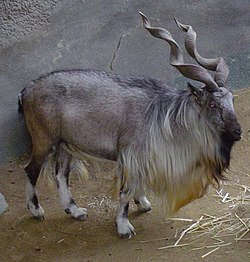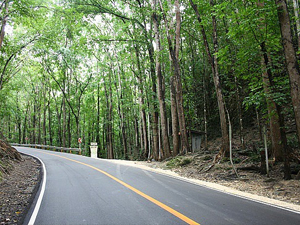
Conservation in Pakistan is the act of preserving, guarding, or protecting, biodiversity, environment, and natural resources of Pakistan.

Conservation in Pakistan is the act of preserving, guarding, or protecting, biodiversity, environment, and natural resources of Pakistan.
The protected areas serve the purpose of conserving the forests and wildlife of Pakistan. National Conservation Strategy of 1993 was a major landmark of start of conservation of natural resources and wildlife in Pakistan. Resource-managed man-made forests like Changa Manga, Kamalia plantation and Chichawatni plantation have also been planted to serve purpose and conserve forests. Through conservation, a large region of Thal desert has been afforested.


Cheer pheasant, which became extinct in Pakistan, was planned to be reintroduced in the region. The World Pheasants Association sent 90 eggs of the species to the Dhodial Pheasantry. Among the eggs which hatched, the mortality was high and remained high till 1995. This situation got better in 1996. In 1997, a parent flock of 40 pairs was raised and eventually reintroduction of the cheer pheasant in Hazara District was carried out. As of 2007, there are around 60 pairs of cheer pheasant in the Dhodial Pheasantry.
Pakistan Crane Center is a conservation center for the captive breeding of common crane and demoiselle crane. It is located west of Kurram River in Lakki Marwat, Khyber Pakhtunkhwa, Pakistan, 250 kilometres (155 mi) south of Peshawar. The center is equipped with a total of 15 circular aviaries as well as an education block for visitors. [7] The center is operated by the Bannu Wildlife Division, Bannu and Pakistan Wetlands Programme of Ministry of Environment (Pakistan). The programme is funded by WWF - Pakistan, GEF, UNDP and Darwin Initiative. [8]
| | This section is empty. You can help by adding to it. (October 2014) |
| | This section is empty. You can help by adding to it. (October 2014) |
Tank is the capital city of Tank District, Khyber Pakhtunkhwa, Pakistan. The city is located northwest of Dera Ismail Khan, and southeast of Jandola, Tank Subdivision. Lakki Marwat and Bannu lies to the northeast while South Waziristan lies to the west.

Bannu District is a district in Bannu Division of Khyber Pakhtunkhwa province in Pakistan. It was recorded as a district in 1861 during the British Raj. It is one of 26 districts that make up the Khyber Pakhtunkhwa province of Pakistan. It borders North Waziristan to the northwest, Karak to the northeast, Lakki Marwat and Bettani to the southeast, and South Waziristan to the southwest. It is represented in the provincial assembly by four MPAs.

The Marwat is a Pashtun tribe, a branch of the Lohani tribe and belong to Lodi section, located primarily in Lakki Marwat District, parts of Dera Ismail Khan District, some villages of Tank district in Pakistan and in the Katawaz area of Afghanistan. The Marwats are also known as Spin Lohani, and their most closely related kin are other Lohani tribes like Miankhel (Pasani), Daulat Khel and Tatur. The Marwats were named for their ancestor Marwat Khan Lodi.

Ayubia National Park, also known as Ayubia, is a protected area of 3,312 hectares (33 km2) located in Abbottabad District, Khyber Pakhtunkhwa province, Pakistan. It was declared a national park in 1984. Ayubia was named after Muhammad Ayub Khan (1958–1969), second President of Pakistan. The area supports temperate coniferous forest and temperate broadleaf and mixed forest ecoregion habitats, with an average elevation of 8,000 feet (2,400 m) above sea level. Ayubia National Park is surrounded by seven major villages and three small towns of Thandiani, Nathiagali and Khanspur. The park has been developed as a resort complex from a combination of four mini resorts of Khaira Gali, Changla Gali, Khanspur and Ghora Dhaka in Galyat. Currently, it is managed by the Wildlife and Parks Department of Government of Khyber Pakhtunkhwa.

The Himalayan subtropical pine forests are a large subtropical coniferous forest ecoregion covering portions of Bhutan, India, Nepal, and Pakistan.

The Changa Manga is a planted forest which includes a wildlife preserve, in the Kasur and Lahore districts of Punjab, Pakistan. It is located approximately 80 kilometers south-west of Lahore. It was once the largest man-made forest in the world but has undergone illegal deforestation at a massive scale in recent times.

The Bettani, also spelled Baittani or Bhittani, is a Pashtun tribe located mostly in Afghanistan and Pakistan. The Bettani are named after Shaykh Beṭ, their legendary ancestor who is said to be the second son of Qais Abdur Rashid. The Bettani's are Sunni Muslims of Hanafi sect. The Bettani confederacy includes the tribes of Bettanis, and Matti tribes progeny of BiBi Mattu daughter of Sheikh Bettan. These include Lodi also known as Lohani, as well as the tribes of Marwat, and Niazi while Shirani has also been mentioned as part of Bettanis.
The Inevitable Flight is a documentary film made by Pakistani documentary filmmaker Azfar Rizvi.

The Western Himalayan subalpine conifer forests is a temperate coniferous forests ecoregion of the middle and upper elevations of the western Middle Himalayas of Nepal, India, and Pakistan.

The forestry sector of Pakistan is a main source of lumber, paper, fuelwood, latex, medicine as well as food and provide ecotourism and wildlife conservation purposes. 4.91% of Pakistan's land is covered in forest.The Shangla district is the only district of Pakistan that composed of more than 80% of forest land
Crane Conservation Center and Wildlife Park, Lakki Marwat is a conservation center for the captive breeding of various types of wild birds and animal species. It is located west of Kurram River in Lakki Marwat, Khyber Pakhtunkhwa, Pakistan, 250 kilometres (155 mi) south of Peshawar. It was established in 2007. The center is equipped with a total of 15 circular aviaries and 20 cages as well as an education block for visitors. The center is now maintained and operated by Khyber Pakhtunkhwa Wildlife Department through the Bannu Wildlife Division, Bannu while its establishment was funded by WWF - Pakistan, GEF, UNDP and Darwin Initiative. A "Range Officer" of the wildlife department manages and co-ordinates the activities of the park. A wildlife veterinarian, Adnan Khan, frequently visits the center in order to maintain healthy stock.
Dhodial Pheasantry is a pheasantry and breeding center for several species of pheasants situated in Mansehra District, Pakistan. It has been set up for the purposes of research, conservation, tourism, and education. The pheasantry has around 250 exhibits providing shelter to around 4,000 birds.
Biosphere reserves are established according to the UNESCO's Man and the Biosphere Programme (MAB) to promote sustainable development for conservation of biological and cultural diversity. As of 2016, the Lal Suhanra Biosphere Reserve and Ziarat Juniper Forest are the only two biosphere reserve in Pakistan, which were approved by UNESCO in 1977 and 2013 respectively. A number of initiatives and projects have been undertaken to promote and develop other biosphere reserves in Pakistan but due to weak implementation this has not yet been materialized. In July 2012, Pakistan Museum of Natural History and Beijing Museum of Natural History signed a MoU to work on trans-boundary biodiversity and to improve MAB related activities in the Karakoram, Himalaya, and Hindukush regions.
Shah Hassan Khel is a village to the south of Lakki Marwat, in the Lakki Marwat District, on the Lakki Marwat Road between Lakki Marwat and Shahbaz Azmat Khel. In 2011, it had some 4,000 inhabitants in about 500 households. The village is located between two streams which lead down from a southern tributary of the Tochi River. The area to the south is mountainous, known as the Sheikh Badin Range. Struggling from insecurity since around 2007, the 2010 Lakki Marwat suicide bombing took place here killing at least 105 people and wounding more than 100 others.

Frances A. Crane Wildlife Management Area is a wildlife management area (WMA) in Falmouth, Massachusetts, operated by the state Department of Fish and Game.

Peshawar Zoo is one of the largest zoos in Pakistan and the first ever zoo in Peshawar. It opened on 12 February 2018. It is managed by the Forests, Environment and Wildlife department of the Government of Khyber Pakhtunkhwa.

The Baluchistan xeric woodlands ecoregion covers the middle elevations of a series of mountain ranges of western Pakistan and northeastern Afghanistan, reaching 1,200 kilometres (750 mi) from the Arabian Sea in the south to the Hindu Kush Mountains and the Himalayas in the north. The characteristic vegetation is xeric (dry) woodlands of shrubs and herbaceous cover. The region has rich biodiversity but relatively few endemic species.

Juniperus seravschanica is a species of juniper. Common names include Pashtun juniper.